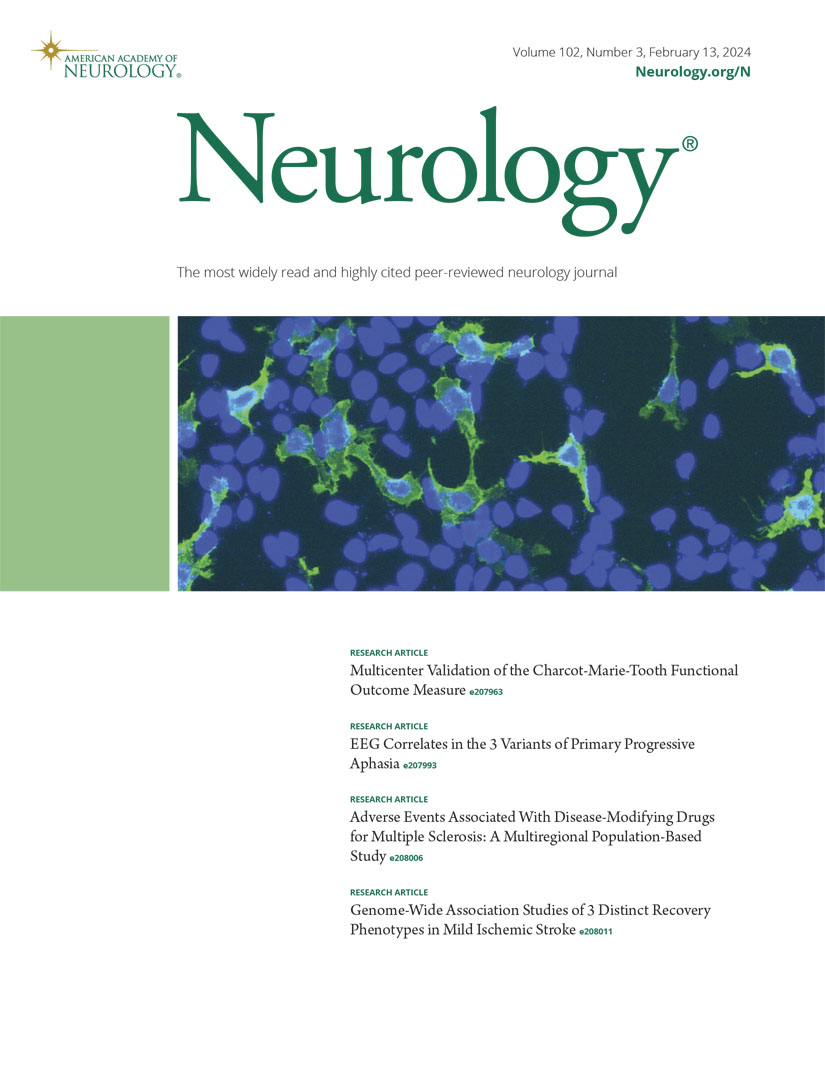神经结节病患者复发的相关因素
IF 7.7
1区 医学
Q1 CLINICAL NEUROLOGY
引用次数: 0
摘要
背景与目的5 - 10%的结节病患者表现为累及神经系统。鉴于神经结节病的严重性和不可逆神经损伤的高风险,快速诊断、准确预后和个体化治疗至关重要。本研究的目的是确定与神经结节病复发相关的因素。方法在这项多中心回顾性队列研究中,纳入了2010年1月1日至2024年6月30日期间在欧洲6个三级神经免疫学中心诊断为可能、可能或明确神经结节病的患者。参与中心从各自基于医院的数据库中识别患者。评估临床表现、影像学结果、脑脊液分析和免疫抑制治疗。复发的预测因素,定义为临床复发或进展,或在初始表现后随访≥2个月的新MRI病变,采用log-rank检验和Cox回归模型进行分析,并评估临床实践中的治疗策略。探讨了确定的危险因素(RFs)与治疗策略之间的关系。结果共纳入174例神经结节病患者,中位随访24个月(四分位数间距12-48.8)。平均年龄48.1岁,女性占57.5%。中枢神经系统实质病变,包括脑炎、脊髓炎和视神经炎(风险比[HR] 2.3, 95% CI 1.3-4.2);csf特异性寡克隆带(ocb) (HR 2.1, 95% CI 1.3-3.6);脑脊液葡萄糖<40 mg/dL (HR 2, 95% CI 1.1-3.4);脑脊液蛋白≥1,000 mg/dL (HR 2.1, 95% CI 1.3 ~ 3.5)为复发的RFs。3-4次RFs患者的中位无复发生存期为12个月(95% CI 4.3-19.7),而1-2次RFs患者为36个月(95% CI 24.3-47.7),无RFs患者为120个月(95% CI 2.1-237.9) (p < 0.01)。治疗升级的可能性随着RFs数量的增加而增加,从无RFs患者的14.3%分别增加到1-2或3-4 RFs患者的28.2%和50% (p < 0.01)。特异性rf的识别,包括实质病变、ocb、脑脊液葡萄糖<40 mg/dL和脑脊液蛋白≥1000 mg/dL,可以更好地预测预后,并可能为个性化治疗方法提供信息。多次复发的患者有更大的复发风险,这可能表明需要更积极的治疗。本文章由计算机程序翻译,如有差异,请以英文原文为准。
Factors Associated With Relapse in Patients With Neurosarcoidosis.
BACKGROUND AND OBJECTIVES
Five to 10 percent of patients with sarcoidosis show involvement of the nervous system. Given the serious nature of neurosarcoidosis and the high risk of irreversible neurologic damage, rapid diagnosis, accurate prognostication, and individualized treatment are crucial. The aim of this study was to identify factors associated with relapses in neurosarcoidosis.
METHODS
In this multicenter retrospective cohort study, patients diagnosed with possible, probable, or definite neurosarcoidosis between January 1, 2010, and June 30, 2024, at 6 tertiary neuroimmunology centers across Europe were included. Patients were identified from the respective hospital-based databases by the participating centers. Clinical presentation, imaging results, CSF analysis, and immunosuppressive therapies were evaluated. Predictors of relapse, defined as clinical relapse or progression, or new MRI lesions on follow-up ≥2 months after initial manifestation, were analyzed with log-rank tests and Cox regression models, and therapeutic strategies in clinical practice were assessed. The association between identified risk factors (RFs) and therapeutic strategies was explored.
RESULTS
A total of 174 patients with neurosarcoidosis were included with a median follow-up of 24 months (interquartile range 12-48.8). The mean age was 48.1 years, and 57.5% were female. CNS parenchymal lesions including encephalitis, myelitis, and optic neuritis (hazard ratio [HR] 2.3, 95% CI 1.3-4.2); CSF-specific oligoclonal bands (OCBs) (HR 2.1, 95% CI 1.3-3.6); CSF glucose <40 mg/dL (HR 2, 95% CI 1.1-3.4); and CSF protein ≥1,000 mg/dL (HR 2.1, 95% CI 1.3-3.5) were identified as RFs of relapse. Patients with 3-4 RFs had a median relapse-free survival of 12 months (95% CI 4.3-19.7), compared with 36 months (95% CI 24.3-47.7) in patients with 1-2 RFs and 120 months (95% CI 2.1-237.9) in patients without RFs (p < 0.01). The likelihood of treatment escalation increased with the number of RFs, from 14.3% in patients without RFs to 28.2% and 50% in patients with 1-2 or 3-4 RFs, respectively (p < 0.01).
DISCUSSION
The identification of specific RFs, including parenchymal lesions, OCBs, CSF glucose <40 mg/dL, and CSF protein ≥1,000 mg/dL, enables better prognostication and might inform individualized treatment approaches. Patients with multiple RFs are at greater risk of relapse, possibly suggesting the need for more aggressive therapies.
求助全文
通过发布文献求助,成功后即可免费获取论文全文。
去求助
来源期刊

Neurology
医学-临床神经学
CiteScore
12.20
自引率
4.00%
发文量
1973
审稿时长
2-3 weeks
期刊介绍:
Neurology, the official journal of the American Academy of Neurology, aspires to be the premier peer-reviewed journal for clinical neurology research. Its mission is to publish exceptional peer-reviewed original research articles, editorials, and reviews to improve patient care, education, clinical research, and professionalism in neurology.
As the leading clinical neurology journal worldwide, Neurology targets physicians specializing in nervous system diseases and conditions. It aims to advance the field by presenting new basic and clinical research that influences neurological practice. The journal is a leading source of cutting-edge, peer-reviewed information for the neurology community worldwide. Editorial content includes Research, Clinical/Scientific Notes, Views, Historical Neurology, NeuroImages, Humanities, Letters, and position papers from the American Academy of Neurology. The online version is considered the definitive version, encompassing all available content.
Neurology is indexed in prestigious databases such as MEDLINE/PubMed, Embase, Scopus, Biological Abstracts®, PsycINFO®, Current Contents®, Web of Science®, CrossRef, and Google Scholar.
 求助内容:
求助内容: 应助结果提醒方式:
应助结果提醒方式:


